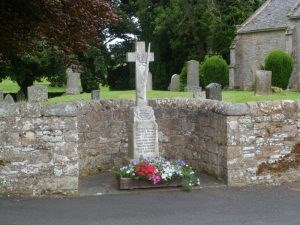Birtley Parish History
The name Birtley (or Birkley) is derived from the Old English words ‘beorht’ meaning bright and ‘ley’ meaning fallow: bright clearing/pasture. The parish stretches from the fertile banks of the River North Tyne in the west to the open moorland of Buteland Fell to the north.
 Evidence of prehistoric and medieval cultivation bears witness to the importance of farming in this area, and contrasts with the later industrial remains from ironstone, coal, and lime extraction. Several surviving burial cairns indicate early human activity in the Bronze Age, and the remains of British camps encircling the village indicate the area has been settled since at least the Iron Age. The Roman road called Dere Street crosses the eastern part of the parish on its route between Corbridge and High Rochester.
Evidence of prehistoric and medieval cultivation bears witness to the importance of farming in this area, and contrasts with the later industrial remains from ironstone, coal, and lime extraction. Several surviving burial cairns indicate early human activity in the Bronze Age, and the remains of British camps encircling the village indicate the area has been settled since at least the Iron Age. The Roman road called Dere Street crosses the eastern part of the parish on its route between Corbridge and High Rochester.
A grave marker built into the walls of St Giles church dates back to the eighth century and another stone may also be pre-Conquest in date.
Post Norman Conquest there is evidence of former villages, a monastic grange, Mediaeval field systems, cultivation terraces and iron workings. The parish church, dedicated to St Giles, is Early Norman and was built about the end of the 11th Century. The district was formerly part of the barony of Prudhoe and belonged to the potent Umfraville family, who arrived in England with William the Conqueror and to whom they are said to be related.
The late Middle Ages saw the region beset with internal strife. Border Rievers were Scottish and English families whose lawless activities plagued the Anglo-Scottish border from the late 13th century to the beginning of the 17th century; they raided the entire Border country without regard to their victims’ nationality. In these troubled times the countless raids and skirmishes resulted in the building of a tower at Birtley, and defensive bastles (fortified farm houses) at High Carry House and Carrycoats Hall
As well as agriculture, evidence of other post-medieval economic activities include rare calcining kilns associated with the extensive iron workings at Broomhope, coal workings, brick and tile works, and lime kilns to slake limestone for agricultural use.
For a century, beginning in 1862, the Border Counties Railway, construction of which was linked to a scheme by the Duke of Northumberland to alleviate local hardship, had a significant impact along the North Tyne valley. Today the railway has gone but the parish retains its rural character, with agriculture and forestry as its economic mainstay. However Millknock sandstone quarry, tourism and wind turbine farms also influence the local economy.
The population in 1801 was calculated at 490 and in 1851, 428. By 2011 the total of residents had declined to 172 (Office for National Statistics)
Rupert Malise Speir
He was born at Saltoun in 1910, and educated at Eton and Pembroke College, Cambridge and became a solicitor in 1936. He served in the Army throughout the Second World War, being commissioned in the Intelligence Corps in 1939, and retiring with the rank of Lt-Col in 1945.
He became the member of parliament for Hexham in the general election which returned his party to power in 1951. This was a particularly appropriate seat for him, since he had spent a large part of his childhood and youth in Northumberland, where his father had leased land from the Duke.
He served as Parliamentary Private Secretary at the Foreign Office, the Commonwealth Relations Office, and the Admiralty. Three important pieces of legislation were sponsored by him as a backbench MP. In 1958 there was the Litter Act, in 1960 the Noise Abatement Act and, in 1963 the Local Government (Financial Provisions) Act.
Honoured as Knight Commander of the Most Excellent Order of the British Empire in 1964 and became chairman of Smith’s Potato Crisps in 1967.
He died on 16th September 1998 and is buried in St Giles Churchyard with a headstone (special permission having been granted) bearing the readily recognizable emblem of the Houses of Parliament; a crowned portcullis.
He was born at Saltoun in 1910, and educated at Eton and Pembroke College, Cambridge and became a solicitor in 1936. He served in the Army throughout the Second World War, being commissioned in the Intelligence Corps in 1939, and retiring with the rank of Lt-Col in 1945.
He became the member of parliament for Hexham in the general election which returned his party to power in 1951. This was a particularly appropriate seat for him, since he had spent a large part of his childhood and youth in Northumberland, where his father had leased land from the Duke.
He served as Parliamentary Private Secretary at the Foreign Office, the Commonwealth Relations Office, and the Admiralty. Three important pieces of legislation were sponsored by him as a backbench MP. In 1958 there was the Litter Act, in 1960 the Noise Abatement Act and, in 1963 the Local Government (Financial Provisions) Act.
Honoured as Knight Commander of the Most Excellent Order of the British Empire in 1964 and became chairman of Smith’s Potato Crisps in 1967.
He died on 16th September 1998 and is buried in St Giles Churchyard with a headstone (special permission having been granted) bearing the readily recognizable emblem of the Houses of Parliament; a crowned portcullis.
